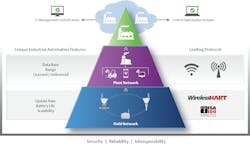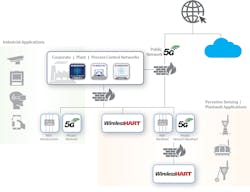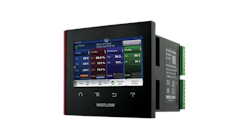How to select the right industrial wireless instrumentation protocol
When looking at wireless development in the industrial automation space, there has been a massive deployment of new wireless components over the last 12 years. With that long history of development, the available choices for industrial protocols — including WirelessHART, ISA100, Wi-Fi, LoRa, 5G and others — have continued to increase. As process industry firms plan and invest, each must select the right wireless infrastructure approach.
Companies successfully implementing wireless infrastructure in their facilities typically evaluate technologies against five criteria:
- The wireless technology must meet current application needs as well as future use cases to maximize the investment return.
- The wireless infrastructure must meet site-specific product certifications not only in North America but also globally.
- The solution must be flexible to deploy, allowing it to fit with the diverse architectures unique to each process facility.
- The solution must be compatible with the existing site security architectures.
- The solution must integrate with existing IT/OT network management practices.
Since no single wireless protocol fits every criterion, coverage is generally separated into a field network and a facility or plant network (see Figure 1). This is necessary because there are unique features required for each type of application to deliver overall operational analytics solutions.
When examining these protocols with respect to specific industrial automation requirements, one can identify the leading protocols designed for the intended use cases. In processing facilities, the most common choices are Wi-Fi and 5G cellular for mobile worker and data backhaul, used with WirelessHART and ISA100 for process control and monitoring instrumentation. Choosing one over the other for each use case requires careful evaluation.
Evaluating wireless protocols
Wireless protocols are complex because there are so many variables that must be optimized for specific use cases. Most are direct trade-offs, such as range and power consumption. Primary protocol factors include:
- Range: How far does it need to send/receive data?
- Data handling: Does it send small data packets infrequently or large amounts of data on a near-continuous basis? Is communication bidirectional? How critical is it that every transmission gets through?
- Power consumption: Can it operate on batteries for an acceptable length of time, or does it require an external power source?
- Reliability: Do we require greater than 99.9% uptime, or are occasional brief outages tolerable.
These are all related to the application and use case. Once defined, the list of viable protocol options quickly gets shorter and secondary factors emerge:
- Topology: Point-to-point, star or mesh?
- Environment: “Office-quality” hardware, industrial grade or rated for use in hazardous areas?
- Frequency: Licensed or unlicensed?
- Network: Public or private?
- Communication cost: Do we own the network and equipment, or is there an ongoing monthly charge to a service provider?
- Interoperability: How many companies make compatible components, such as process instruments and valve actuators? Do our preferred vendors use this protocol?
- Security: How well is the communication protected from interference and interception?
Field network selection
Some evaluations are relatively simple. For example, many control hardware manufacturers have adopted Bluetooth to improve field instrumentation commissioning and calibration. If a technician wants to upload new configuration settings to a valve positioner from a laptop, this can be done easily using Bluetooth rather than a cable, perhaps even avoiding the need to open the enclosure.
Similarly, it can also be used to commission a new process transmitter in the shop or field, improving overall safety as many transmitters are in hard-to-reach locations. Bluetooth is a short-range personal-area network designed for these types of ad hoc cable replacement opportunities and, as such, is a perfect example of using a technology as intended.
As applications become more complex, so does the selection process (see Figure 2). Consider selecting a protocol for wireless process instruments and valves. There are two protocols, WirelessHART and ISA100.11a, designed specifically for this application. The two have many similarities but are incompatible due to significant differences in networking topology. There are many resources that discuss the nuances in far greater detail, but it is important to remember that these two protocols were specifically designed for process monitoring, noncritical control and asset condition monitoring applications.The discussion has recently become more complicated with more choices emerging. LoRa was originally designed for building automation and smart city applications, and it is now being promoted for industrial use. Since this protocol is designed to send small amounts of data long distances on a daily or weekly basis, it does have certain advantages in terms of range, but there are also drawbacks for meeting industrial automation needs. One of the most familiar applications for the LoRa protocol is smart power meter monitoring, which is used by utility companies to track daily power consumption and to provide their customers with a daily or weekly report between billing cycles.
One critical feature for industrial instrumentation is update rate. This setting will vary across a process facility depending on the criticality of the measurement — and the rate of change of the process and variable — for both control and monitoring applications. Since LoRa was designed for residential utility meter monitoring, the update rate and data reliability were relatively unimportant since utility measurements change slowly and only move in one direction. As a result, utility providers were not concerned with occasional missed measurements.
This is not the case in a processing facility, even in low-criticality monitoring applications. Update rates must be flexible to support engineering studies, changing process conditions and evolving regulatory reporting requirements. Today, regulations may call for hourly update rate data, but if it changes to every 30 seconds next year, the instruments and the network may not be able to support the new demand. When a process or equipment issue is identified and operations need to track the issue more closely to avoid an unplanned failure, the network may not be able to accommodate updates every five seconds.
Facility of plant network evaluations
Digital transformation projects involve far more kinds of wireless devices than just process instruments and asset condition monitors. Processing facilities and plants can have all sorts of wireless applications, including but not limited to:
- Mobile tablets and phones.
- Robotics and machine control.
- Surveillance cameras.
- Augmented reality.
- Autonomous vehicles and drones.
Most wireless devices deployed in a plant ultimately send their data through some local access point or gateway to a backhaul network connected to larger corporate networks. For some years now, the typical solution has been Wi-Fi combined with wired Ethernet to handle this task.
Wi-Fi was designed for such use and has worked well for plant-wide backhaul and other wireless applications. It can be scaled up to handle enormous amounts of data and is highly interoperable with equipment available from a variety of vendors. At the same time, setting up true plant-wide coverage in a processing environment is expensive due to the number of components and amount of cabling required. Industrial-grade access points and routers are much more expensive than consumer- or commercial-grade equipment, and many are required to cover a wide area due to the greater amounts of interference found in industrial environments.
This reality is now being challenged by a different approach rapidly gaining ground in a wide range of applications, albeit most of them are nonindustrial, and that is 5G.
Cellular enters the fray
5G represents the latest generation of cellular connectivity, and it is reaching into the industrial world. Most general discussion touts enhanced mobile broadband (eMBB) for smartphones and tablets, with major improvement compared to 4G, aimed at virtual reality media, UltraHD video and other high-bandwidth applications. eMBB supports data rates up to 20 Gbps with up to 10,000 times higher traffic than 4G systems. Network speed and brute data-handling capabilities are truly extraordinary under the right conditions.
Two additional areas have drawn attention from industrial users:
- Ultra-reliable low-latency communications (URLLC) provides support for critical systems requiring extremely low latency, such as self-driving vehicles and machine control. URLLC offers transport latency of less than 1 ms with data rates up to 10 Mbps. Like eMBB, URLLC relies on the use of the 5G New Radio (5G NR).
- Massive machine-type communication (mMTC) supports machine-to-machine communication with data rates up to 100 Kbps. mMTC applications include municipal metering and smart city deployments where extremely low data rates (e.g., once per day or less) and high latency are acceptable.
Because Wi-Fi uses unlicensed radio spectrum, an end user can purchase equipment off-the-shelf and install it themselves. 5G uses licensed radio spectrum, requiring either end users or telecommunications companies to apply for radio spectrum licenses and pay a recurring fee. Some favoring the 5G approach may even ask: Why shouldn’t we use 5G for all applications, including device-level networks and process instrumentation? Is WirelessHART necessary at all?
This is certainly a legitimate question as proponents characterize 5G as suitable for virtually any wireless use case, although other protocols may be optimized for specific applications. This may sound like a viable option at first glance, but let’s consider replacing WirelessHART with 5G for a typical process instrument or condition monitoring sensor (see Figure 4). The first table shows a slow update rate of 60 seconds, and the second table shows a more typical update rate of eight seconds.
As Figure 4 shows, WirelessHART is optimized for long battery life, which is critical because process manufacturing users are greatly concerned about maintenance costs and availability. To many companies, even a five-year battery life is considered impractical, and 5G devices do not even meet this benchmark. Beyond overall battery performance, there are additional costs to consider when using licensed spectrum, as these expenditures can reach as much as 20% of the transmitter cost every year.
Much of this consideration is theoretical in any case due to device availability. Even if a facility decides it wants to use 5G for instrumentation, it will soon discover that few, if any, selections are available. Instrumentation and field device manufacturers must be convinced of the long-term viability of a new communication protocol before they take the step of creating new products. This chicken-and-egg dilemma of product availability and customer demand invariably creates a time when it is unclear if a new approach will get off the ground.
As a case in point, Wi-Fi-enabled field transmitters have never gained traction due to high-power requirements and other limitations, in spite of the large number of plants using such networks for other applications.
Best tool for the job
Optimizing performance and cost depends on matching the tool to the job. So far, no single wireless protocol has proven itself ideal for every industrial use case, nor is any flexible enough to match all requirements. It is therefore critical to examine the requirements of the application and select a suitable solution. In many respects, it is remarkable that a facility as complex as a large-scale chemical plant can accomplish all necessary tasks with as few as four or five protocols.
For the foreseeable future, the growth of pervasive sensing as part of a digital transformation will be supported by WirelessHART, a protocol that has proven itself resilient and adaptable to new demands and opportunities.
Tom Bass
Tom Bass is the pervasive sensing product management director at Emerson Automation Solutions in Shakopee, Minnesota. Bass started his career with Emerson in 2004 in Marshalltown, Iowa, and held many roles within the valve business prior to moving to digital transformation in October 2016. Most recently, he led the pervasive sensing business development team with a focus on growing the Plantweb digital ecosystem. In his current capacity, he is responsible for leading product management for pervasive sensing and manages the Plantweb wireless instrumentation and analytics portfolio. Bass holds a bachelor’s degree in mechanical engineering from Iowa State University and an MBA from The University of Iowa.






